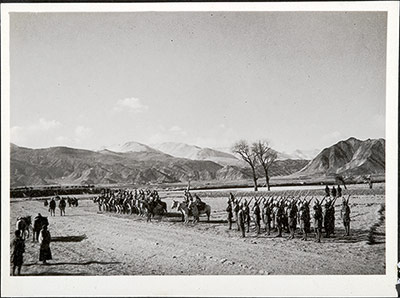
1999.23.1.33.1 (Album Print black & white)


1999.23.1.33.1 (Album Print black & white)

H. Staunton ?
Harry Staunton
January - June 1940
Sir Basil Gould, Hugh Richardson?, Innes-Keys?
Gyantse
1999.23.1.33.1
119 x 89 mm
Administration
Print gelatin silver
Donated 1999
Diana Hughes
H. Staunton
Diana Hughes
Notes on print/mount - "Guard of Honour. 1/15 Punjab Reg. Gyantse" is written in blue ink on the reverse of the image. Also, the number: 468V is written in pencil in the top right hand corner. [KC 11/1/2006]
Notes on album mount - "Gyantse" is written in pencil and in capital letters in the centre of the page as a joint caption for the four photographs on this page of the album. [KC 11/1/2006]
Manual Catalogues - "The Escort is aligned" [Hugh Richardson in conversation with Roger Croston, detailed in H. Staunton undated Related Documents File, PRM Manuscript Collections]
Other Information - Setting: Alex McKay writes about the Gyantse Trade Agency in Tibet and the British Raj , 1997, Richmond: Curzon Press, "On 1 October 1904, with no formalities beyond raising the flag, the Gyantse Trade Agency began operations in Chang Lo ('Willow Garden'), a country house which the younghusband mission had used as its Gyantse base. In addition to local employees, O'Connor [the British Trade Agent] had a number of European staff. There was a British officer of the India Medical Service ... and a military escort consisting of 50 India soldiers, which was normally under the command of a British officer. There was also a European Head Clerk to oversee clerical staff recruited from the Darjeeling area, two Indian Army telegraph sergeants responsible for communications and a third in charge of supply and transport.'(p. 17) The structure of the administration remained very much the same until the demise of the Agency in 1948 [?]. Gyantse was selected because it was seen to be a commercially important meeting point of trade routes from India, Shigatse and Lhasa. [KC 11/1/2006]
For Citation use:
The Tibet Album.
"Review of troops at Gyantse, 1940"
05 Dec. 2006. The Pitt Rivers Museum.
<http://tibet.prm.ox.ac.uk/photo_1999.23.1.33.1.html>.
For more information about photographic usage or to order prints, please visit the The Pitt Rivers Museum.
© The Pitt Rivers Museum